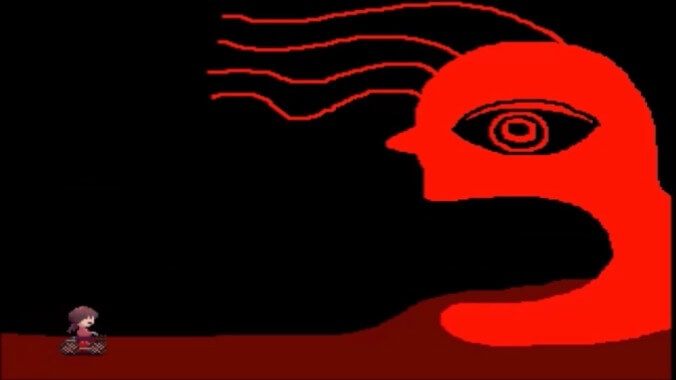One of the most mysterious games ever made has suddenly returned from the void

I have never beaten Yume Nikki, but that was also sort of the point. I half-suspected that upon completion a candy-colored demon girl would reach out of my monitor and pull me into it. It’s a game about dreams that plays like one, with inscrutable puzzle logic and obtuse RPG menus, full of images and phrases that merge and linger in the mind afterward. It’s unafraid of long washes of nightmarish imagery and uneasy ambient tones, all displayed without explanation. Much of its playtime is spent making long forays into sprawling, repetitive dream worlds that ladder into even more surreal realms. There are fields of human organs, SNES-styled forests full of ghostly girls, washes of abstract color that turn into labyrinthine subterranean malls. Playing it inspires a strange mixture of terror, despair, and melancholy that at once urges you to walk away and compels you to return, so singular is its mood. Even today, 14 years after this lo-fi landmark first appeared, there’s very little out there like it.
When the game came out in 2004, it passed among people like a rumor. This was years before the first indie game boom of Braid and Super Meat Boy, when the internet was wily and less, shall we say, social. Yume Nikki was released without fanfare in Japanese, later to be translated by a fan into English. It would receive a handful of updates over the ensuing years, culminating in version 0.10 in 2007, before its designer, Kikiyama, seemingly abandoned the game and the internet entirely. Only an old email address hidden in a ReadMe file points toward Kikiyama, and fans have puzzled over their location, existence, and general well-being repeatedly in the years since. Their fear for the latter was brought on, in part, by Yume Nikki’s ending: After corralling 25 random objects from throughout its sprawling world, you splay them out in a central room, and then lead the game’s protagonist, a video game obsessive who only ever leaves her room by dreaming, off a balcony to her death. Speculation that Kikiyama met a similar fate simmered in Yume Nikki’s fan communities .
And now, a decade after it was abandoned to the internet, the game has suddenly reappeared on Steam, along with a new official website counting down to next Thursday and an eight-minute teaser revealing a sequel called Yume Nikki: Dream Diary. Kikiyama’s suicide, it turns out, was as much a part of the fan speculation as anything else.
The game is often held up as a predecessor to the Gone Home-driven walking-simulator movement, but its open-ended nature lacks the tightly designed narrative thrust of those games. It plays out, despite the finality of its ending, much more like a sandbox, with weird interactions and back corners intended to be rooted out and toyed with infinitely. A knife can be found and used to kill almost any character in the game—with no effect. Walk up a back staircase and into a cutscene of a flashing, demonic face, replete with baleful Angelo Badalamenti synths. In a pastel forest, a princess waits in a quiet room, but if you flick the lights off, she may randomly turn into a leering ghost. In the corner of an Aztec labyrinth, a glowing monkey presides over a banging synth-pop rave.
Many of these moments became memes of their own; all of them have been subjected to rigorous literary scrutiny by the game’s legions of devotees. It’s spawned countless imitators, fan sequels, spiritual successors, and comics, thanks in part to the density of the original game’s enigma, a black hole that sucks in players and speculation and spits back only more queasy imagery. The old, weird internet was good at creating these sorts of mysteries. Today, creepypasta is a cliché genre of cutesy Tim Burton-DeviantArt and spurious viral marketing, but back in 2004, it was part of a broader zeitgeist, a cultural certainty that out in the vast digital wilds horrible things lurked. Japanese horror movies like Ju-On, Ringu, and Pulse were grappling with the lines between technology, isolation, and death; Yume Nikki and its endless mysteries worked less like a commentary on these themes and more like a digital manifestation of them. The game was proof that the internet was haunted and that games might contain within them the dreams of lonely, wandering souls. If Slenderman is the original cursed image, then Yume Nikki is the original cursed game, an ancient artifact—dated aesthetically even when it was originally released—that seemed placed in our world by an unseen hand.
And now it’s got a sequel coming out. The obvious risk is that it fails to live up to the infinite spectral gloominess of its predecessor. What would be even worse is if the sequel earnestly attempts to build on the first game and still falls flat in 2018, when its type of horror has been replicated ad infinitum and there is nothing mysterious left on the internet. You can almost imagine Kikiyama getting doxxed these days, or their new game being somehow politicized, absorbed into an internet where everything is funneled into a few tried and true channels of outrage or adoration. Will the game be modernized at all, take inspiration from the games it inspired, barrel along its own path even further, or take an abrupt left-turn? Has Kikiyama’s design ethos developed, their art or music matured?
The only real metric of the game’s success, at least as far as I’m concerned, is that it remains as confusing and unyielding as its predecessor—that it rejects players and scrutiny with the exact intensity that it absorbs them. That the game is returning at all changes the way people will approach Yume Nikki forever, removing some of the vast mystery that surrounds it. The best we can hope for the new game is that it creates mysteries of its own.